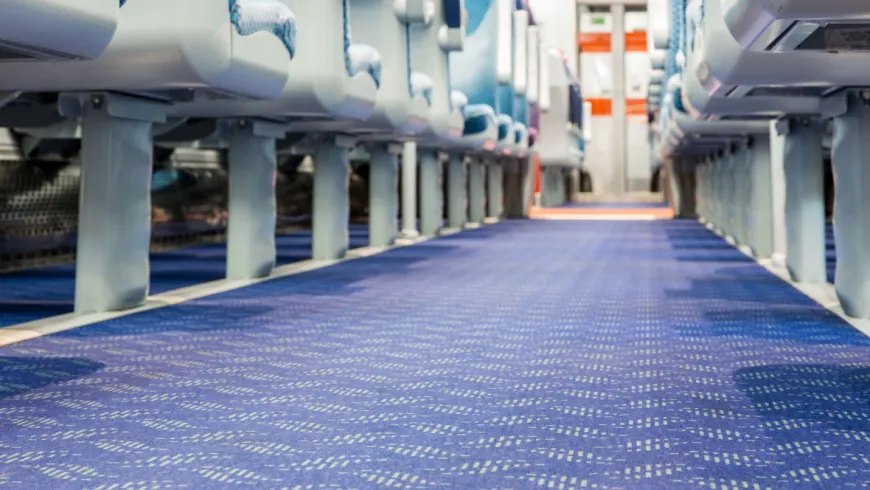Flooring Tool: Sustainable Practices and Materials in the Manufacturing of Flooring Products
Textile carpenting is a flooring option made from natural and manufactured textile materials like jute, sisal, seagrass, coir and synthetic materials like polypropylene, nylon and polyester.

Textile carpenting is a flooring option made from natural and manufactured textile materials like jute, sisal, seagrass, coir and synthetic materials like polypropylene, nylon and polyester. It provides homeowners with a sustainable and durable flooring alternative to traditional hard flooring materials like hardwood, laminate, vinyl and ceramics.
Advantages of Flooring
Textile floors are eco-friendly
Most textile carpenting materials are made from natural fibers that are renewable and biodegradable like jute, sisal and coir. Their production involves minimal processing and does not harm the environment. They can be recycled at the end of their usable life, making textile floors a green flooring choice.
Textile floors are durable
Though they may appear delicate, Textile Flooring can withstand daily foot traffic and last for many years when installed correctly. The tough natural fibers feel resilient underfoot and don't show wear and tear easily. Regular vacuuming helps keep them looking fresh for long.
Textile floors are comfortable
The soft, cushioned feel of natural textile floors makes them very comfortable to walk and stand on. This is unlike hard floor surfaces that can cause footsteps to echo and back/feet to hurt after prolonged standing. Textile floors enhance comfort.
Textile floors are cost-effective
While the initial investment may seem less compared to hard floors, textile floors are very cost-effective in the long run. They don't require frequent refinishing or replacement. Minimal maintenance keeps the costs low over the years. Do-it-yourself installation also reduces professional installation charges.
Textile floors are warm underfoot
Unlike cold hard floors, textile floors feel cozy underfoot and help retain warmth. This makes them ideal for bedrooms, nurseries and other rooms where warmth and comfort take priority over other flooring attributes. Their insulating quality also aids heating bills in winters.
Types of Flooring Tool
Jute Flooring
Jute is one of the most popular eco-friendly choices. Made from pulp of jute plants, it comes in plain whites and off-whites usually. Jute floors have a coarse, burlap-like texture that feels hardy underfoot.
Sisal Flooring
Made from agave plants fiber, sisal floors have a textured woven appearance and are very durable. Available in natural colors ranging from creamy whites to tawny browns, they work well in rustic, beach homes and farms.
Seagrass Flooring
Woven from long strands of seagrass, usually found in ocean waters around Africa, seagrass floors have a unique textured look with varied hues of straw, taupe and grey tones. Their handcrafted charm enhances coastal decor styles.
Coir Flooring
Produced from coconut husk fibers, coir floors have a denser texture than jute or sisal. Earthy tan shades suit a relaxed, laidback aesthetic. Coir withstands high moisture areas like bathrooms very well.
Synthetic Flooring Tool
Made with polypropylene, polyester or nylon, synthetic floors like sisal-look and jute-look imitations provide durable, easy-care options where natural varieties aren’t suitable. They withstand high footfall and moisture.
Installing and Caring for Textile Floors
Proper subfloor preparation is vital before installing any textile floor. Subfloors must be clean, dry and levelled. Underlayment provides a cushioned base and aids sound insulation. Loose lay or adhesive installation methods are common. Edging trims keep floors safe from possible moisture damage at perimeter edges.
Regular vacuuming lifts away surface dirt. Spills should be wiped immediately to avoid permanent stains setting in. Annual deep cleaning protects floor fibers. Furniture legs must have floor protectors. Places prone to excessive moisture may need occasional drying. With simple care like this, textile floors can enhance home décor beautifully for years to come.
As a sustainable yet affordable flooring option, textile carpenting popularity is rising each year. Along with obvious eco-benefits, natural characteristic variation, beautiful tactile quality and comfort underfoot make them an exciting alternative or addition to conventional flooring portfolios. With proper installation and maintenance practices, textiles are certain to impress as a long-lasting, attractive investment for homes and commercial spaces alike.
Get more insights Textile Flooring Market
Discover the Report for More Insights, Tailored to Your Language
About Author:
Ravina Pandya, Content Writer, has a strong foothold in the market research industry. She specializes in writing well-researched articles from different industries, including food and beverages, information and technology, healthcare, chemical and materials, etc.












